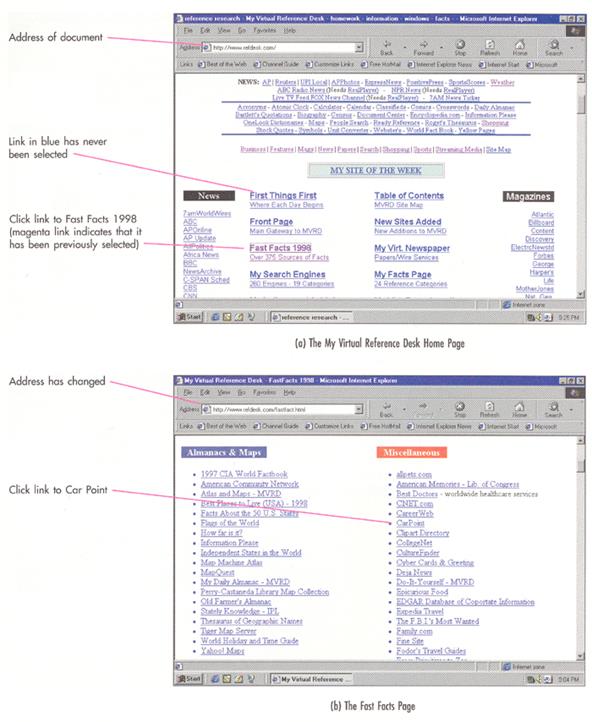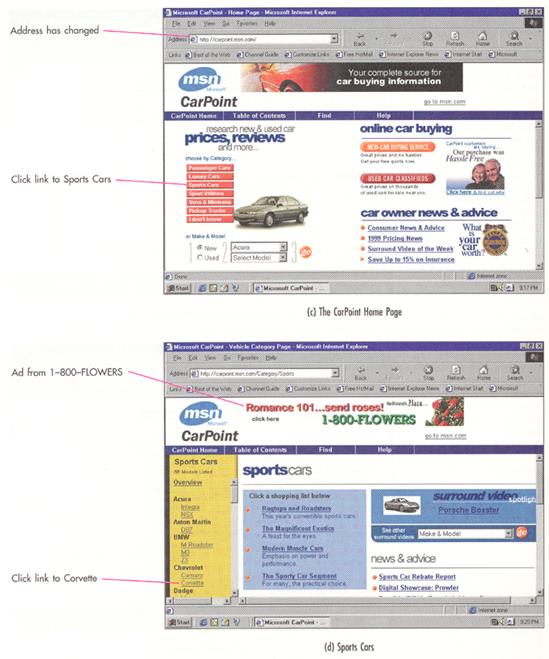HYPERTEXT TRANSFER PROTOCOL (HTTP)
In order for the Web to work, every client (be it a PC or a Mac) must be able to display every document from every server. This is accomplished by imposing a set of standards known as a protocol to govern the way data is transmitted across the Web. Thus, data travels from client to server, and back, through a protocol known as the HyperText Transfer Protocol (or http for short). In addition, in order to access the documents that are transmitted through this protocol, you need a special type of program known as a browser. Indeed, a browser is aptly named because it enables you to inspect the Web in a leisurely and casual way (the dictionary definition of the word "browse"). Internet Explorer 5.0 (IE5) is the browser we use throughout the text.
Consider, for example, the hypermedia documents in Figure 1. To display these documents on your computer, you would need to be connected to the Internet and you would need to know the address of the first document, in this case, www.refdesk.com. (Yes, it helps to know the addresses of interesting Web pages, and we suggest several sites to explore in Appendix B.) We describe the structure of Internet addresses later in the chapter, but for the time being, suffice it to say that every server, and every document on every server, has a unique address. The "http" that precedes the address indicates that the document is being transferred according to the hypertext transfer protocol we discussed earlier.
The first document displayed by a Web site is its home page; thus the document in Figure la is the home page of My Virtual Reference Desk and it is one of our favorite sites on the Web. Not only does it demonstrate the concept of hypertext, but by its very nature it elegantly shows the global nature of the World Wide Web. Once you arrive at a Web page, you can click any link that interests you.
Consider, for example, our path through Figure 1. We began by scrolling down the home page of My Virtual Reference Desk in Figure la until we could click the link to Fast Facts 1998. which in turn displayed the document in Figure Lib. Note how the address changes automatically in the address bar. Indeed, that is what the Web is all about as you move effortlessly from one document to another. We then clicked the link to CarPoint. which took us to an entirely different site in Figure lc. Next, we clicked the link to Sports Cars to display the list of cars in Figure ld. (The CarPoint home page provides graphical links as well as underlined text links; that is, each of the buttons on the left side of the page is a link to the respective category.) We clicked Corvette from the list of sports cars in Figure ld then clicked an additional link to display the specific information about the new car in Figure le. We explored the various links on this page, and then ended with the Buying Service in Figure lf
The underlined links that appear in Figure 1 are displayed in one of two colors, blue or magenta, depending on whether or not the link has been previously selected. Any link in blue (the majority of links) indicates the document has not yet been viewed. Links in magenta, however (such as Fast Facts 1998 in Figure la), imply the associated document has been retrieved earlier in that session or in a previous session. Note, too, the presence of advertising on the Web in the CarPoint screens of Figures Lid and e. The vendors (1-800-FLOWERS and Barnes and Noble) pay the host of the site for advertising space in the hope of enticing the visitor to click the advertisement.
Think for a moment of what we have just accomplished. We started with a general reference page and in a matter of minutes were in the process of purchasing a new car. There is no beginning (other than the starting point or home page) and no end. You simply read a Web document in any way that makes sense to you, jumping to explore whatever topic you want to see next. All of this is accomplished with a graphical browser such as Internet Explorer and a connection between your computer and the Internet.



FIGURE 1 The World Wide Web